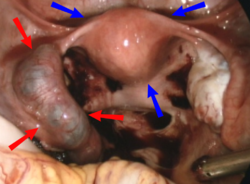Hematosalpinx
(Redirected from Haematosalpinx)
Editor-In-Chief: Prab R Tumpati, MD
Obesity, Sleep & Internal medicine
Founder, WikiMD Wellnesspedia &
W8MD medical weight loss NYC and sleep center NYC
| Hematosalpinx | |
|---|---|

| |
| Synonyms | N/A |
| Pronounce | N/A |
| Specialty | N/A |
| Symptoms | Pelvic pain, abnormal uterine bleeding |
| Complications | Infertility, ectopic pregnancy |
| Onset | Sudden or gradual |
| Duration | Varies |
| Types | N/A |
| Causes | Ectopic pregnancy, endometriosis, tubal surgery |
| Risks | Pelvic inflammatory disease, previous ectopic pregnancy |
| Diagnosis | Ultrasound, laparoscopy |
| Differential diagnosis | Ovarian cyst, pelvic inflammatory disease |
| Prevention | N/A |
| Treatment | Surgery, medication |
| Medication | N/A |
| Prognosis | Depends on cause and treatment |
| Frequency | Rare |
| Deaths | N/A |
Hematosalpinx is a medical condition characterized by the accumulation of blood within the fallopian tubes, which are part of the female reproductive system. This condition can lead to significant discomfort and, if left untreated, may result in complications affecting fertility and overall reproductive health.
Causes
Hematosalpinx is often caused by pelvic inflammatory disease (PID), endometriosis, or ectopic pregnancy. These conditions can lead to the blockage of the fallopian tube, preventing blood from exiting the body during menstruation and leading to its accumulation. Other causes may include tubal surgery, infections, or tumors.
Symptoms
The symptoms of hematosalpinx can vary depending on the underlying cause but typically include pelvic pain, abnormal vaginal bleeding, and in some cases, symptoms of an infection such as fever or unusual vaginal discharge. The pain is often described as a sharp, stabbing sensation on one side of the pelvis.
Diagnosis
Diagnosis of hematosalpinx involves a combination of medical history, physical examination, and imaging tests. Ultrasound is commonly used to visualize the fallopian tubes and detect the presence of fluid accumulation. In some cases, a hysterosalpingography (HSG) or laparoscopy may be performed to further evaluate the condition and its cause.
Treatment
Treatment for hematosalpinx focuses on addressing the underlying cause of the blood accumulation. In cases where infection is present, antibiotics may be prescribed. If the condition is due to endometriosis or ectopic pregnancy, surgical intervention may be necessary to remove the blockage or affected tissue. In severe cases, removal of the affected fallopian tube (salpingectomy) may be recommended to prevent further complications.
Complications
If left untreated, hematosalpinx can lead to infertility, due to damage to the fallopian tubes or the development of scar tissue. Additionally, the condition can increase the risk of future ectopic pregnancies, where a fertilized egg implants outside the uterus, often in the fallopian tube.
Prevention
Preventing hematosalpinx involves managing risk factors for its underlying causes. Regular medical check-ups, practicing safe sex to reduce the risk of PID, and managing conditions like endometriosis can help lower the risk of developing hematosalpinx.
See Also
Transform your life with W8MD's budget GLP-1 injections from $125.
W8MD offers a medical weight loss program to lose weight in Philadelphia. Our physician-supervised medical weight loss provides:
- Most insurances accepted or discounted self-pay rates. We will obtain insurance prior authorizations if needed.
- Generic GLP1 weight loss injections from $125 for the starting dose.
- Also offer prescription weight loss medications including Phentermine, Qsymia, Diethylpropion, Contrave etc.
NYC weight loss doctor appointments
Start your NYC weight loss journey today at our NYC medical weight loss and Philadelphia medical weight loss clinics.
- Call 718-946-5500 to lose weight in NYC or for medical weight loss in Philadelphia 215-676-2334.
- Tags:NYC medical weight loss, Philadelphia lose weight Zepbound NYC, Budget GLP1 weight loss injections, Wegovy Philadelphia, Wegovy NYC, Philadelphia medical weight loss, Brookly weight loss and Wegovy NYC
|
WikiMD's Wellness Encyclopedia |
| Let Food Be Thy Medicine Medicine Thy Food - Hippocrates |
Medical Disclaimer: WikiMD is not a substitute for professional medical advice. The information on WikiMD is provided as an information resource only, may be incorrect, outdated or misleading, and is not to be used or relied on for any diagnostic or treatment purposes. Please consult your health care provider before making any healthcare decisions or for guidance about a specific medical condition. WikiMD expressly disclaims responsibility, and shall have no liability, for any damages, loss, injury, or liability whatsoever suffered as a result of your reliance on the information contained in this site. By visiting this site you agree to the foregoing terms and conditions, which may from time to time be changed or supplemented by WikiMD. If you do not agree to the foregoing terms and conditions, you should not enter or use this site. See full disclaimer.
Credits:Most images are courtesy of Wikimedia commons, and templates, categories Wikipedia, licensed under CC BY SA or similar.
Translate this page: - East Asian
中文,
日本,
한국어,
South Asian
हिन्दी,
தமிழ்,
తెలుగు,
Urdu,
ಕನ್ನಡ,
Southeast Asian
Indonesian,
Vietnamese,
Thai,
မြန်မာဘာသာ,
বাংলা
European
español,
Deutsch,
français,
Greek,
português do Brasil,
polski,
română,
русский,
Nederlands,
norsk,
svenska,
suomi,
Italian
Middle Eastern & African
عربى,
Turkish,
Persian,
Hebrew,
Afrikaans,
isiZulu,
Kiswahili,
Other
Bulgarian,
Hungarian,
Czech,
Swedish,
മലയാളം,
मराठी,
ਪੰਜਾਬੀ,
ગુજરાતી,
Portuguese,
Ukrainian
Contributors: Prab R. Tumpati, MD

